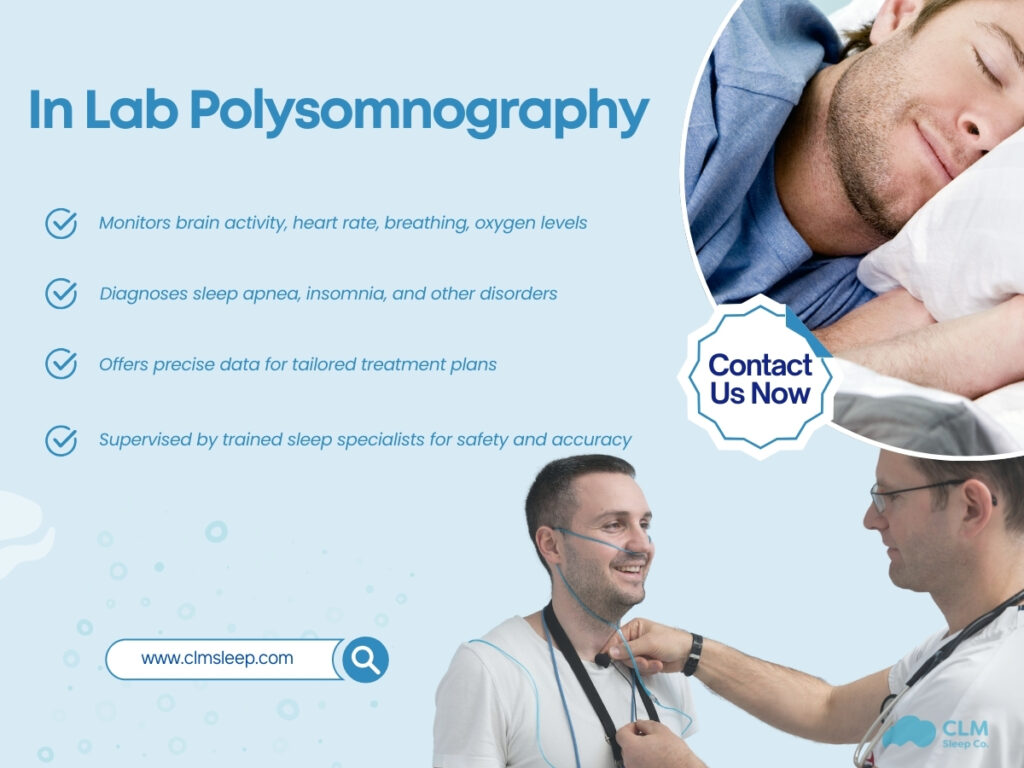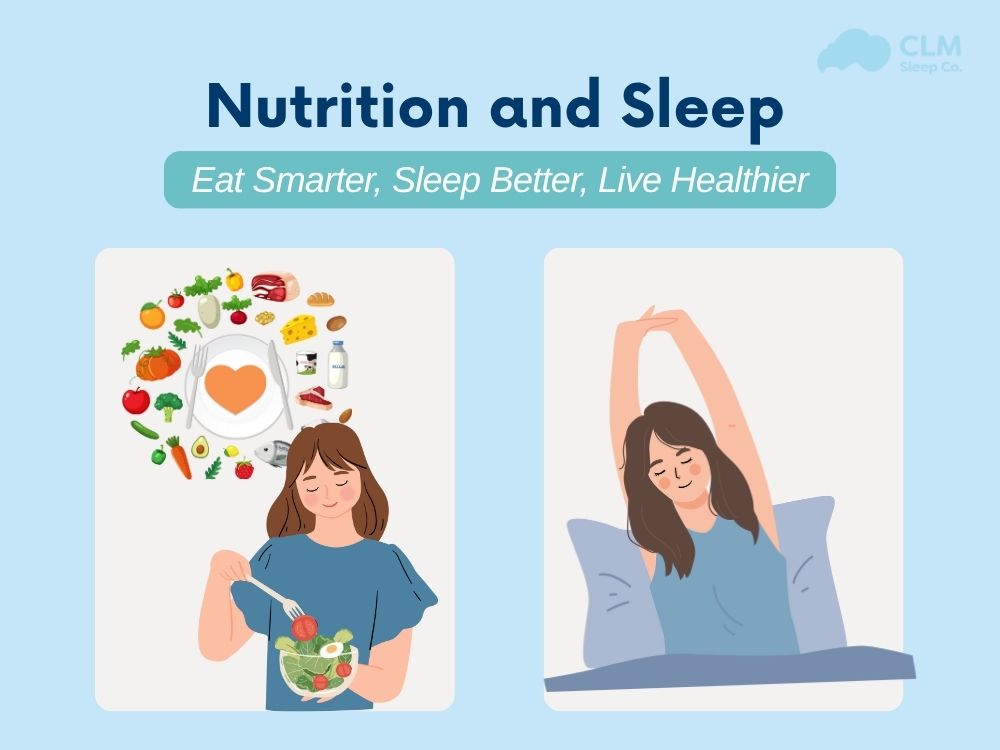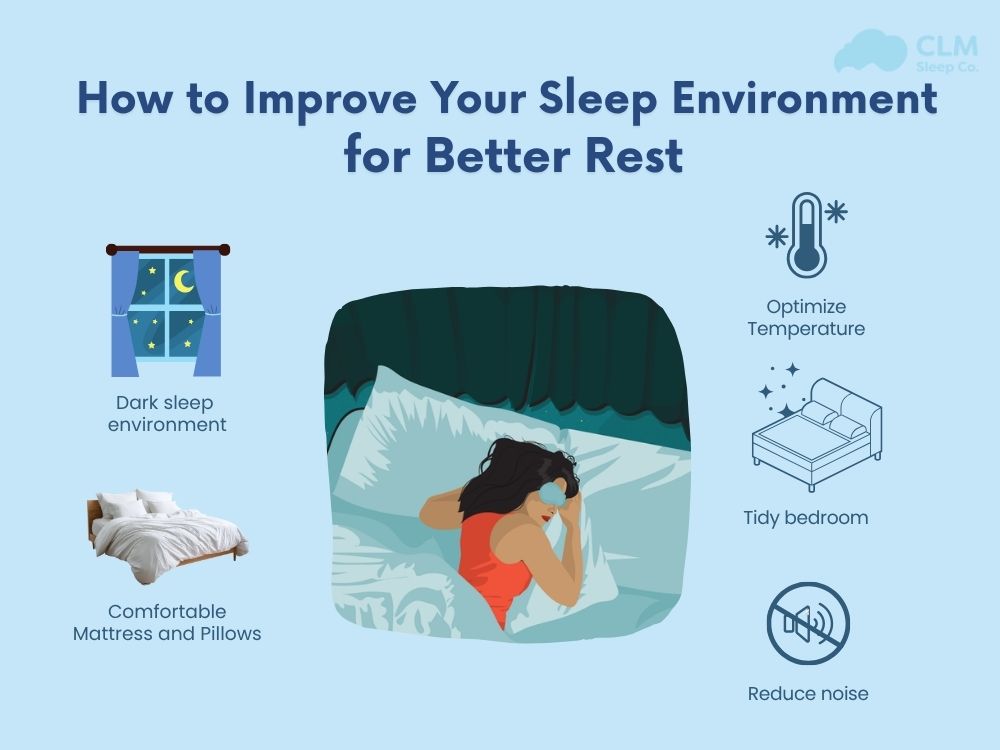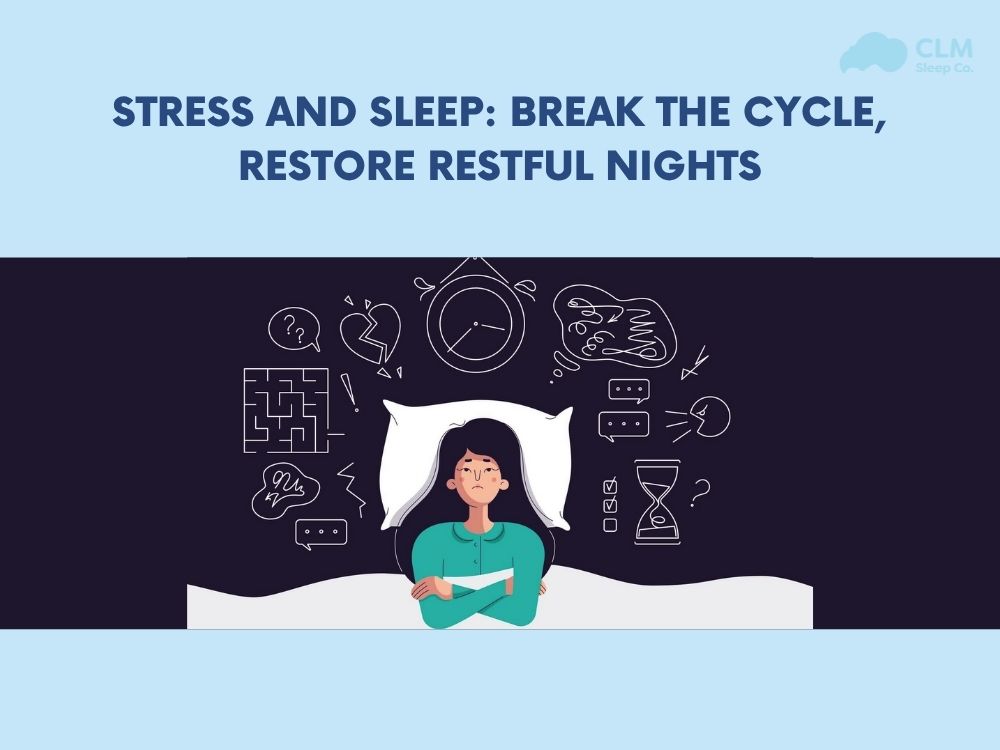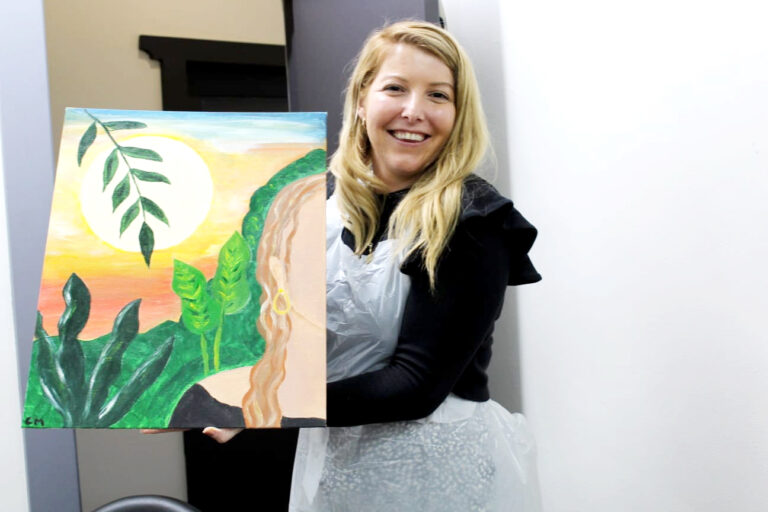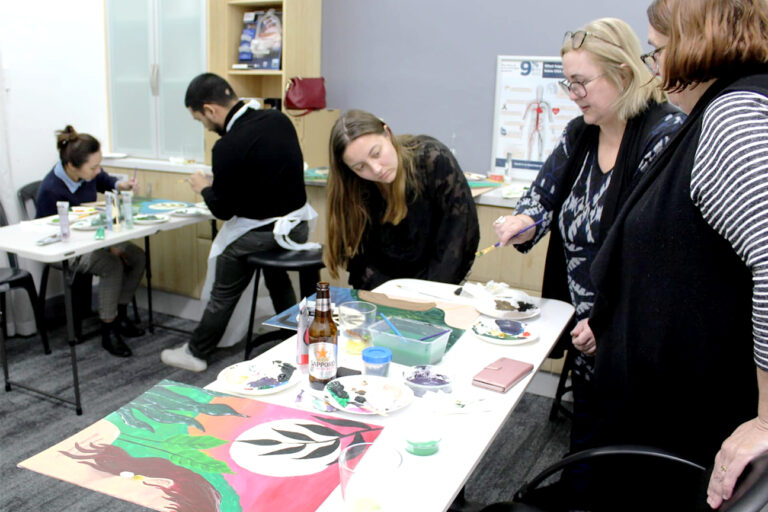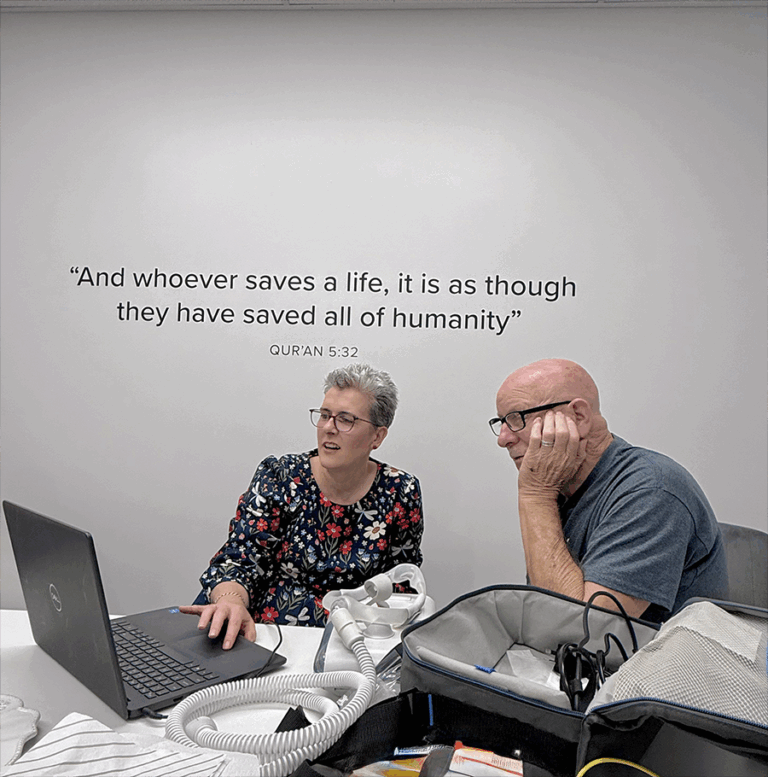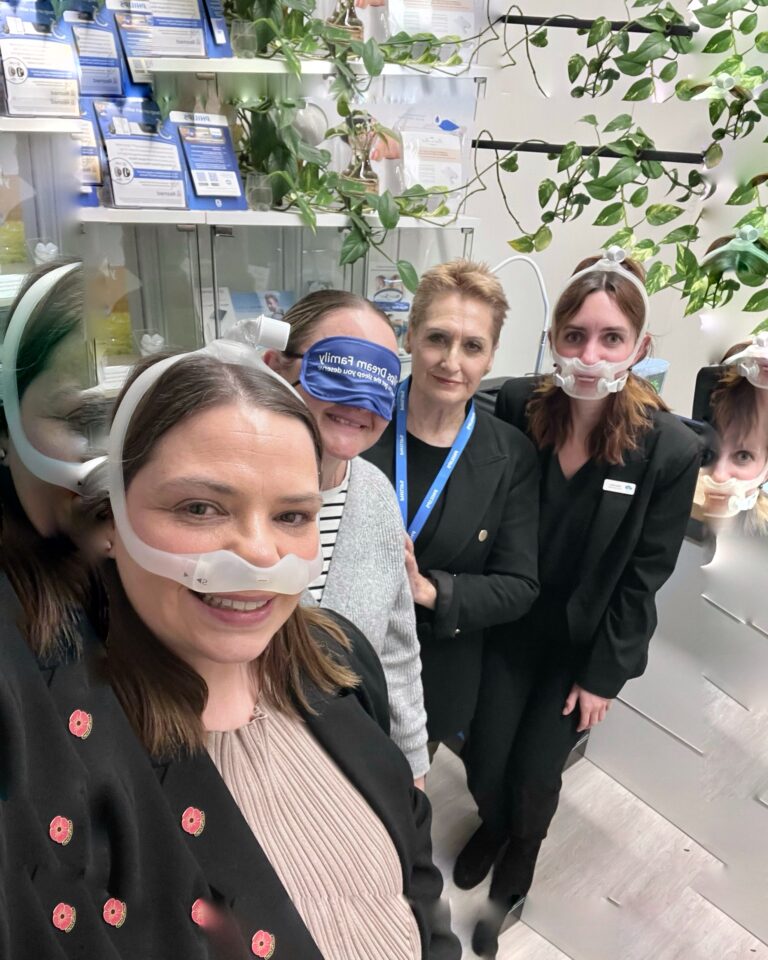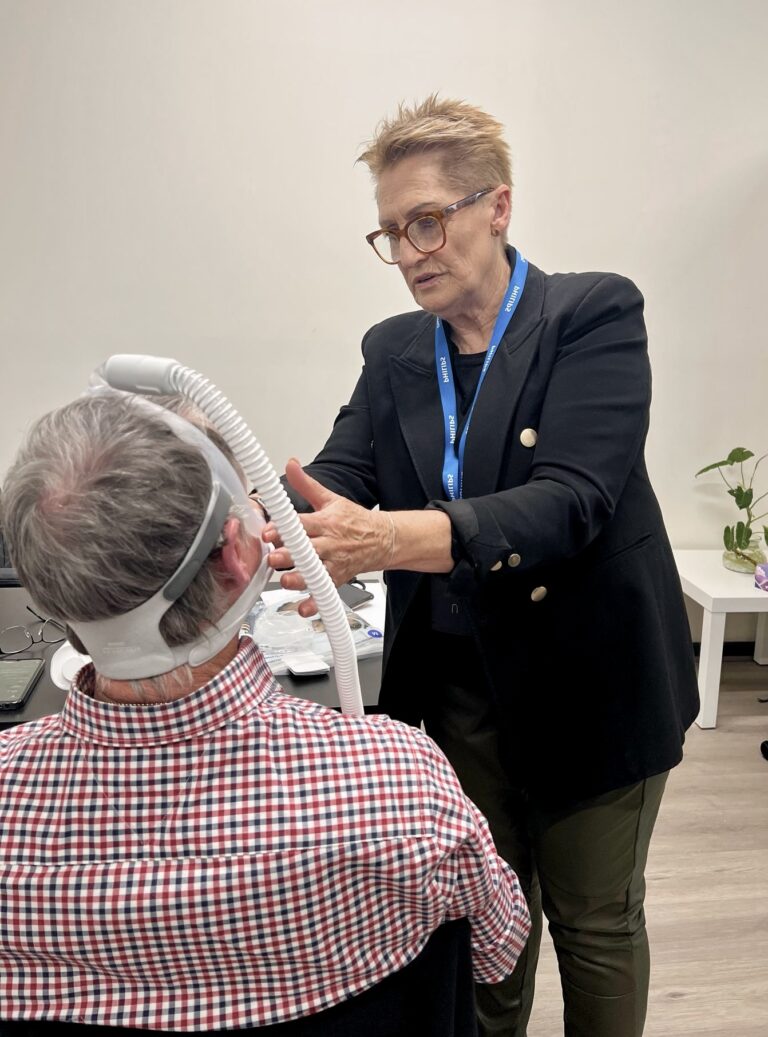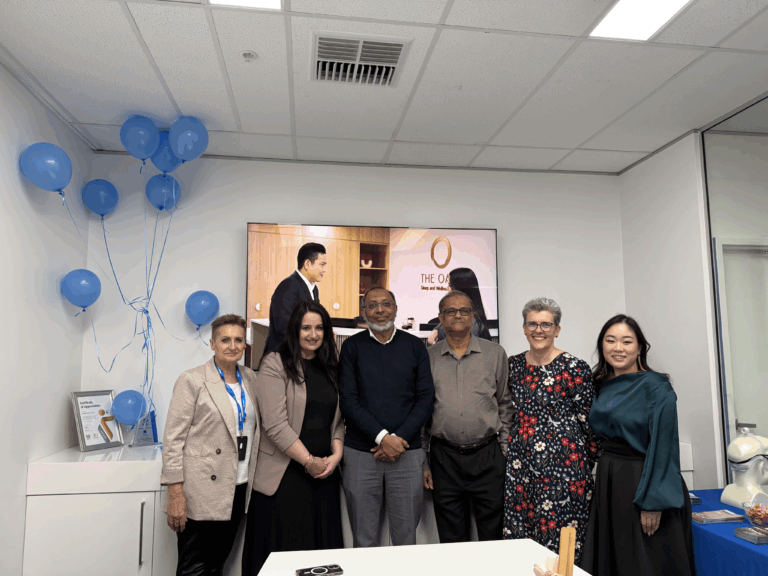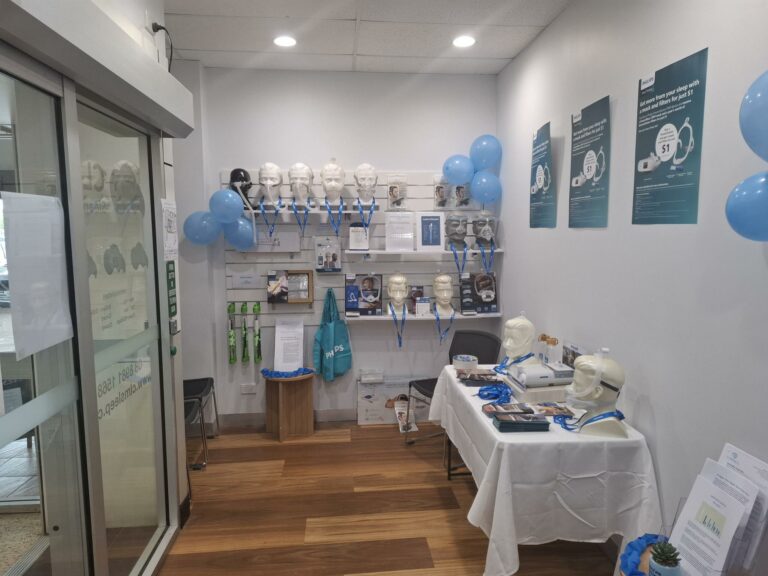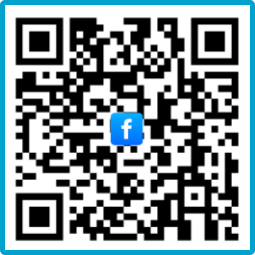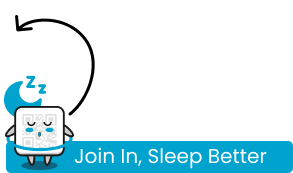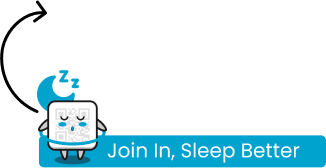Many people have sleep problems, unrecognized disorders, thus cannot find out that can be affecting their well-being. If tired, snore, or spend the nights in turbulence, spend a night in a polysomnography suite. It is in a specialized laboratory setting, using high-tech equipment to monitor and study individual sleep patterns to unearth the genesis of any disruption and allow for personalized treatment. This article on CLM Sleep discusses the procedure, benefits, and how to get prepared for in-lab polysomnography to keep you in the know every step of the way.
What is in lab polysomnography?
In-lab polysomnography (PSG), a type of in-lab sleep study, is a comprehensive test conducted in a controlled environment (laboratory). It lals 6–8 hours overnight to diagnose sleep disorders, especially obstructive sleep apnoea (OSA), by recording brain activity, eye movements, muscle tone, and heart rate.
An in-lab sleep study is more complex than a home sleep study, with about 17 to 20 sensors attached to various parts of the body. These sensors include EEG to measure brain activity, EOG for eye movements, EMG for muscle tone, and ECG for heart rhythm. In-lab polysomnography also monitors breathing patterns, oxygen saturation, and airflow during sleep.
This sleep study analyse the collected information to form a comprehensive view of your sleep. In-lab polysomnography plays an important role in diagnosing many sleep disorders such as obstructive sleep apnoea, insomnia, and restless legs syndrome. This form of sleep study ensures accurate results, allowing healthcare providers to create specific, personalised treatment plans tailored to the individual needs of each patient.
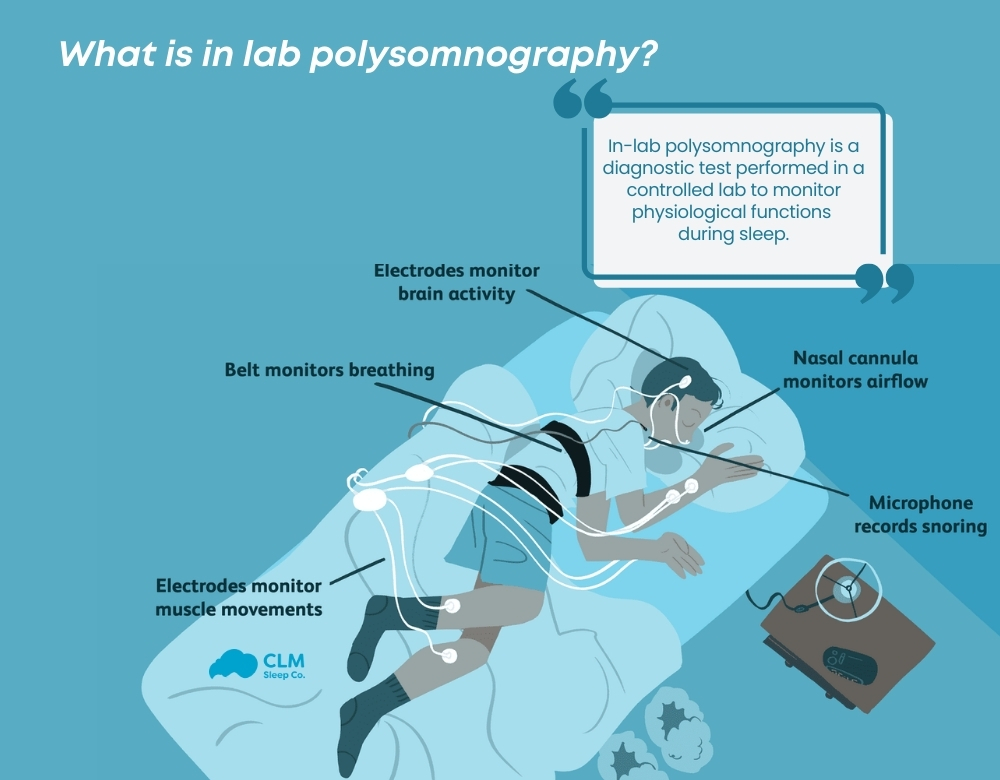
See more:
Identifying Sleep Apnea Symptoms: Are You at Risk?
Why choose in lab polysomnography?
Undergoing in-lab polysomnography has several advantages over HSATs. Laboratory testing is done in a monitored environment with access to high-quality equipment and the constant attention of sleep technologists, making the data collection more reliable.
Unlike HSATs, a lab-based test can measure a wider range of indicators and is suitable for difficult cases.
| Feature | In Lab Polysomnography | Home Sleep Study |
| Accuracy | High | Moderate |
| Monitoring by professionals | Yes | No |
| Range of measurable indicators | Comprehensive | Limited |
| Environment | Controlled | Variable |
A test can diagnose sleep apnea, restless leg syndrome, insomnia, REM behavior disorder conditions and offer a clear path to treatment.
How is in-lab polysomnography performed?
In a laboratory setting, the process is designed as sensitively as possible to ensure accuracy and comfort for the patient. Here’s what to expect at each step:
STEP 1: Preparation before the study
The accuracy of the results largely depends on proper preparation. Before your sleep study appointment, your clinic will give you specific instructions, which usually include:
- Skip caffeine, alcohol, and some meds for 24 hours before the test.
- Wash your hair but don’t use conditioner or styling products.
- Bring comfy pyjamas, toiletries, and something to help you relax
- Stick to a regular sleep routine before the study to keep your sleep on track.
You might need to track your sleep for a few days. This helps your sleep therapist know your routine and when to begin the study. Pre-study Preparation helps you sleep as naturally as possible by creating comfort, avoiding things like caffeine and alcohol, and reducing stress before the study.
STEP 2: Arriving at the lab and device setup
When you arrive at the laboratory, the technician will explain the procedure and help you attach the sensors. These sensors will be attached neatly, safely, and painlessly, so you can change position while sleeping. You can even go to the bathroom at night, just inform the technician to temporarily disconnect it. In-lab polysomnography attaches sensors to measure
- Brain Waves
- Eye Movement
- Breath
- Heart Rate
- Oxygen Level
- Muscle Activity
The sensors will be gently attached to the scalp, chin, chest, limbs, etc. The specific locations of the sensors are:
| Body Location | Sensor Type | Estimated Number of Sensors | Exact Placement |
| Scalp | EEG electrodes (brain waves) | 6–8 | Frontal, central, and occipital regions |
| Near the eyes | EOG electrodes (eye movements) | 2 | Beside each outer eye corner |
| Chin | EMG electrodes (muscle activity) | 2–3 | Below the chin and jaw sides |
| Legs (lower legs) | EMG electrodes (leg movements) | 2 (1 per leg) | Over tibialis anterior on each lower leg |
| Chest | Respiratory belts (breathing effort) | 1 | Around the chest |
| Abdomen | Respiratory belts (breathing effort) | 1 | Around the abdomen |
| Nose | Nasal cannula / Thermistor (airflow) | 1 | Inside the nostrils |
| Mouth | Oral thermistor (airflow) | 1 | In front of the mouth |
| Finger | Pulse oximeter (oxygen saturation) | 1 | Typically on the index finger |
| Earlobe (if used) | Pulse oximeter (alternative location) | 1 (if used) | On the earlobe |
This step usually takes around 30 to 45 minutes. It involves carefully placing the sensors in the correct positions and organising the wires neatly. Doing so ensures both patient comfort during sleep and the accuracy of the data recorded overnight.
STEP 3: Data recording during sleep
After all sensors are correctly in place, monitoring can start. As you fall asleep, advanced monitoring equipment continuously records real-time data throughout the night. This includes:
- Brain waves (EEG): Which helps identify REM and non-REM stages of your sleep cycle.
- Eye movements (EOG): To track transitions between sleep stages, especially REM sleep
- Muscle activity (EMG): Placed on the chin and legs to pick up abnormal movements or muscle activity during sleep.
- Breathing effort and airflow: Sensors around your chest, abdomen, nose, and mouth help detect apnoea (pauses in breathing) and hypopnoea (shallow breathing).
- Heart rate and rhythm (ECG): To identify cardiac irregularities that may be linked to sleep disturbances.
- Oxygen saturation (SpO₂): Pulse oximetry tracks your blood oxygen levels, flagging any significant drops during sleep
This continuous monitoring allows sleep specialists to analyse your sleep architecture, identify the presence and severity of any sleep disorders, such as obstructive sleep apnoea, periodic limb movement disorder, or REM behaviour disorder and tailor appropriate treatment.
STEP 4: Finishing the study and removing devices
In the morning, technicians will carefully remove the sensors. The process is quick and leaves no lasting marks, allowing you to return to your normal routine.
STEP 5: Data analysis and results delivery
After the study, specialists analyse the results from the sleep study. Within one to two weeks, you’ll receive a detailed report outlining the findings and any recommended treatment options.
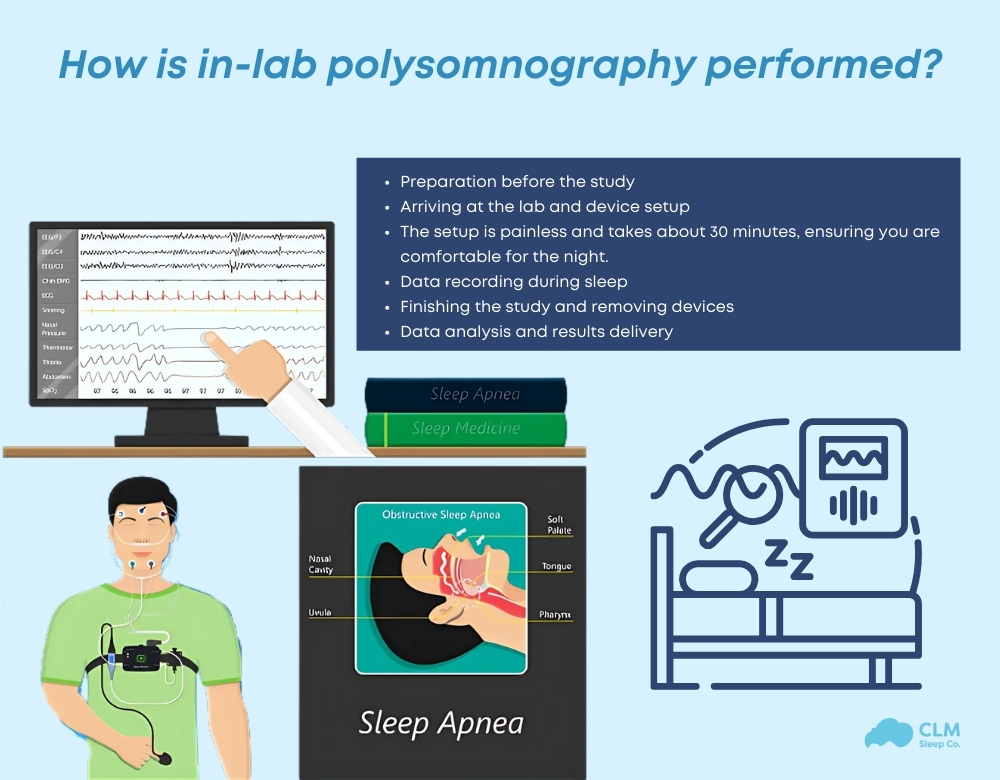
Fee for in lab polysomnography
The in-lab polysomnography may cost a few hundred to a few thousand dollars depending on the institution, the expertise of the staff attending the patient, and tests simultaneously conducted or recordings made. Typically, charges involve equipment, a night stay in the lab, and analysis of data by experts.
Other clinics offer packages with follow-ups, and either the test is covered by insurance if deemed medically necessary, or else check with your clinic and insurer for pricing and coverage details. Financing options or discounts may be available for self-paying patients. Contact your local sleep center for more information.
See more: Sleep Study Cost in Australia
CLM Sleep – A trusted location for in lab polysomnography in Australia
CLM Sleep provides polysomnography services at a modern laboratory in Australia, with a team of highly experienced sleep specialists. Thanks to the application of advanced technology, the clinic comprehensively monitors brain activity, breathing patterns, heart function, and muscle movements to provide accurate diagnoses for sleep disorders.
Not only stopping at diagnosis, CLM Sleep is also committed to providing personalised care services, developing sleep apnoea treatment plans tailored to each patient. Whether it is obstructive sleep apnoea or other complex disorders, the treatment methods always place the patient at the centre to achieve optimal effectiveness.
With modern, convenient facilities and a convenient location, CLM Sleep provides a friendly environment, helping patients feel at ease during the diagnostic process without worrying about stress.
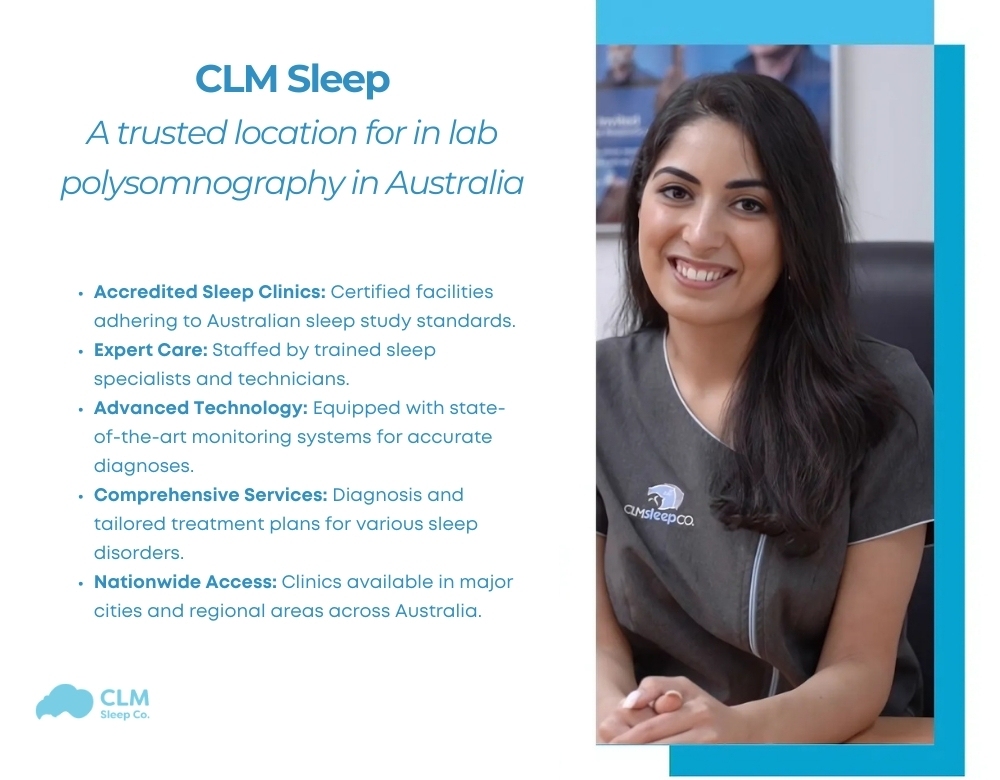
Locations of CLM Sleep’s 6 clinics
Currently, CLM Sleep has 6 clinics in Australia, making it easy for patients to access quality services near their homes. Below are the addresses of the current 6 CLM Sleep clinics:
1. [Head Office] CLM Sleep Co. Kent Town, Adelaide
Address: 57 Fullarton Road, Kent Town, SA, 5067, Australia
Details: Head Office – CLM Sleep Co. Kent Town
2. CLM Sleep Co. Hove
Address: South Australian Medical Specialists 379 Brighton Road, Hove, SA, 5048, Australia
Details: CLM Sleep Co. Hove
3. CLM Sleep Co. Mawson Lakes
Address: Northern Specialist Suites, HMH Towers, Level 1, 42-48 Garden Terrace, Mawson Lakes, SA, 5095, Australia
Details: CLM Sleep Co. Mawson Lakes
4. CLM Sleep Walkerville
Address: Shop 4/80 Walkerville Terrace, Walkerville, SA, 5081, Australia
Details: CLM Sleep Co. Walkerville
5. CLM Sleep Murray Bridge
Address: Murray Bridge Green, Shop 16/1 Swanport Road, Murray Bridge, SA, 5253, Australia
Details: CLM Sleep Co. Murray Bridge
6. CLM Sleep Co. Morphett Vale
Address: 189 Main South Road, Morphett Vale, SA, 5162, Australia
Details: CLM Sleep Co. Morphett Vale
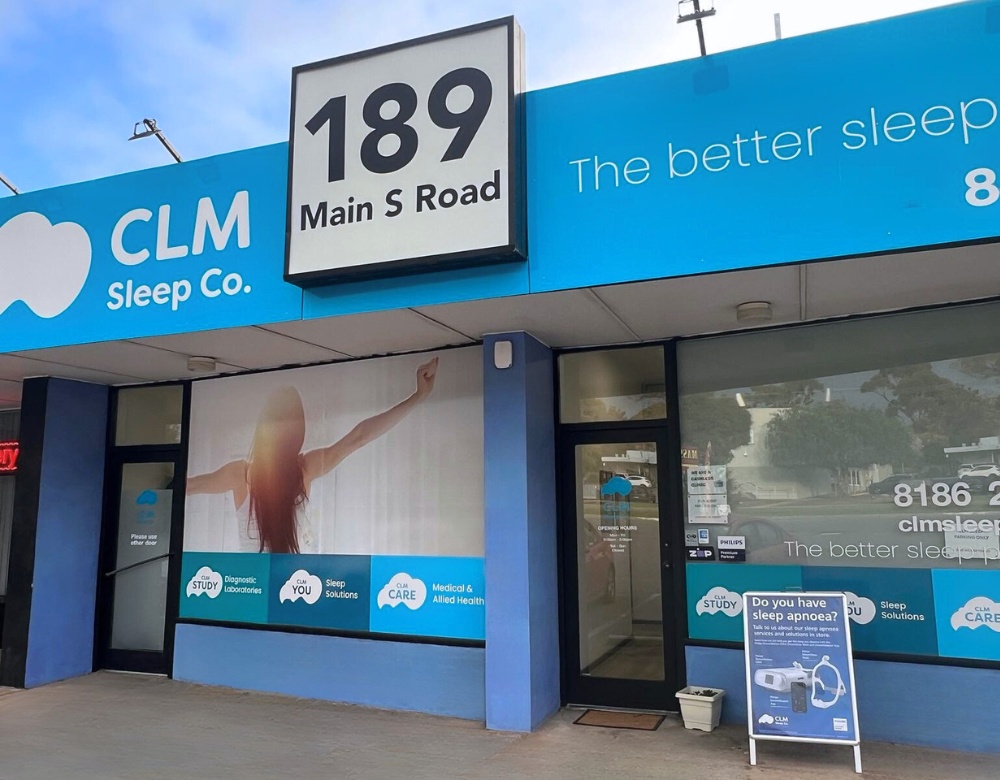
CLM Sleep is the ideal choice for those seeking reliable polysomnography services in Australia – a place where technology, expertise, and dedication to sleep care converge.
See more: 6 CLM Locations Offering In-Lab Sleep Studies
Tips for preparing for your in lab polysomnography
Proper preparation can help ensure accurate sleep study results and make you feel more comfortable. Here are some detailed tips to guide you.
Follow pre-study instructions
- Strictly follow any guidance provided by your sleep clinic, this might involve abstaining from caffeine, alcohol, and large meals in the evening before the study.
- Stick to a routine sleep and wake time in the days leading up to the test. This will help guarantee that your body will be ready for sleep during the study.
Avoid naps on the day of the test
- Avoid naps on the day of the polysomnography to increase the chances that you fall asleep quickly during the test.
- Try to stay active throughout the day, it may promote better sleep that night.
Bring personal comfort items
Pack your pillow, blanket, and even your favorite pajamas. This will help you to relax more and see that home-like environment in the lab. With this, you will have less tension and, as a result, sleep better during the test.
Take care of personal hygiene
- Bathe and have your skin dry, free from lotions, oils, or make-up. This will ensure proper adhesion of the sensors by the technicians to obtain accurate readings.
- Do not use any hair products that might interfere with scalp sensors.
Dress comfortably
Wear loose-fitting two-piece sleepwear (e.g. a pajama set) to facilitate the ease of technicians placing sensors on your body and to ensure that you are comfortable during the test.
Prepare for an overnight stay
- Bring with you all the important things, including medicines, toiletries, and a set of clothes for the next morning.
- Inform the clinic well in advance if you have any particular medical requirements.
Arrive on time
Try to reach by the given time so that there is enough time for the setup process in a relaxed fashion and no extra pressure for the test that follows.
Adherence to these recommendations will help to make the entire process more comfortable for you and obtain the most accurate results from your in-lab polysomnography.
FAQs about in-lab polysomnography
For those unfamiliar with in lab polysomnography, it’s common to have questions. Here are answers to frequently asked questions to help you feel prepared.
Is it uncomfortable to sleep in a lab?
The lab environment is designed to mimic the comfort of home as much as possible. Rooms are quiet, private, and equipped with cozy beds to help you relax. While sensors are attached to your body to monitor various functions, they are placed carefully to minimize discomfort, allowing you to sleep naturally.
What should I expect during the procedure?
The procedure begins with a technician attaching sensors to your scalp, chest, legs, and other areas to record brain activity, breathing, and movement. These sensors are connected to a monitoring device but do not restrict your ability to move. Throughout the process, trained staff will guide you and address any questions or concerns. The goal is to make you feel at ease while gathering accurate sleep data.
How long until results are available?
After the sleep study, the recorded data undergoes detailed analysis by sleep specialists. In most cases, results are ready within a few days. Your healthcare provider will review the findings with you, discuss any diagnosed conditions, and recommend a personalized treatment plan if necessary.
What if I can’t sleep during a sleep study?
Many people worry they won’t be able to fall asleep in a new environment. Sleep technicians are experienced in helping patients relax and are prepared to handle such situations. Even if your sleep is limited, partial data can still provide valuable insights into your sleep patterns and help with diagnosis.
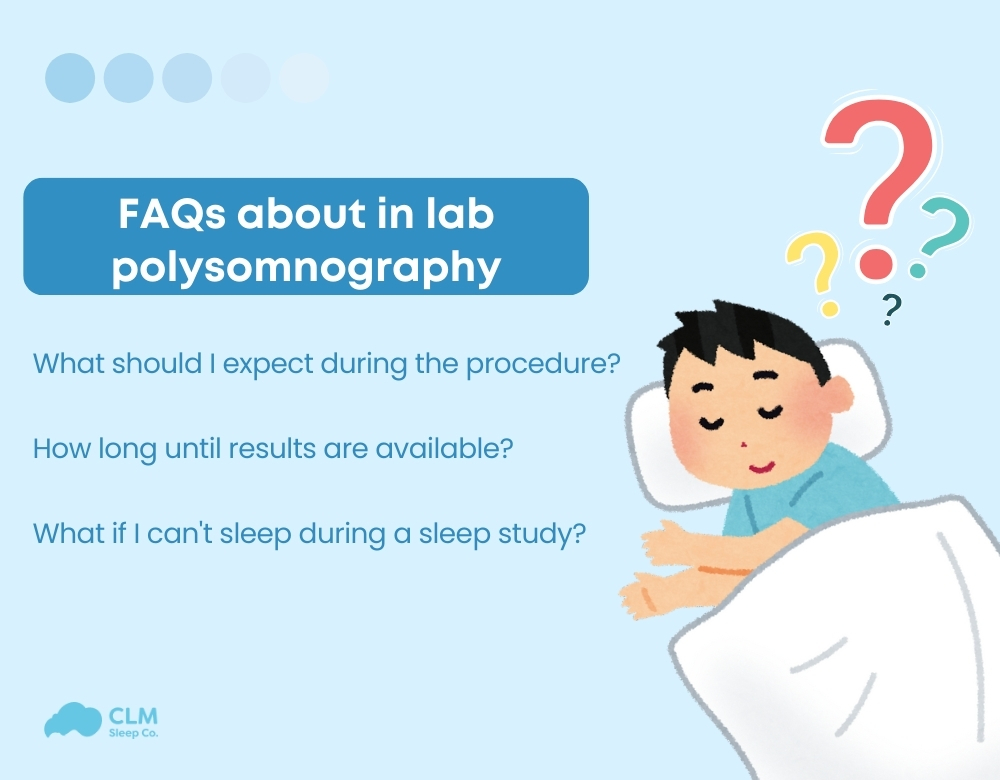
Conclusion of the article
In-lab polysomnography is an essential diagnostic tool for identifying and managing sleep disorders, providing accurate and comprehensive insights into your sleep health. With its controlled environment and advanced technology, this procedure ensures precise results, leading to effective treatment plans tailored to your needs.
If you’re struggling with sleep issues or suspect a sleep disorder, it’s time to take action. Explore CLM Sleep Services for experts in-lab sleep study solutions in Australia. To complement your therapy, find affordable CPAP equipment and accessories at CPAP Discount. Start your journey to better sleep and enhanced well-being now!
Reference
1. Jennifer M. Slowik; Abdulghani Sankari; Jacob F. Collen. Obstructive Sleep Apnea. In: StatPearls [Internet]. Treasure Island (FL): StatPearls Publishing. 2025 Mar.
2. Asghari A, Mohammadi F. Is Apnea‑Hypopnea Index a proper measure for Obstructive Sleep Apnea severity? Med J Islam Repub Iran. 2013 Aug;27(3):161–162. PMID: 24791128; PMCID: PMC3917481.
3. Saeed, S., Romarheim, A., Solheim, E., Bjorvatn, B., & Lehmann, S. Cardiovascular remodeling in obstructive sleep apnea: Focus on arterial stiffness, left ventricular geometry and atrial fibrillation. Expert Review of Cardiovascular Therapy. 2022;20(6):455-464. DOI:10.1080/14779072.2022.2081547. PMID: 35673889
4. Tadic, M., Gherbesi, E., Faggiano, A., Sala, C., Carugo, S., & Cuspidi, C. The impact of continuous positive airway pressure on cardiac mechanics: Findings from a meta-analysis of echocardiographic studies. Journal of Clinical Hypertension (Greenwich, Conn.). 2022;24(7):795-803. DOI:10.1111/jch.14488.PMID: 35695237. PMCID: PMC9278581
